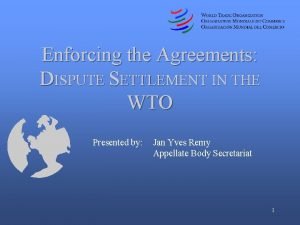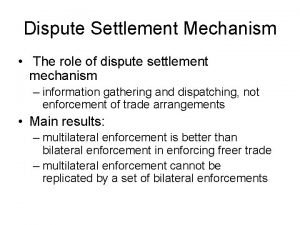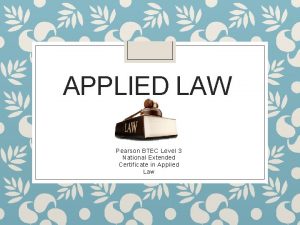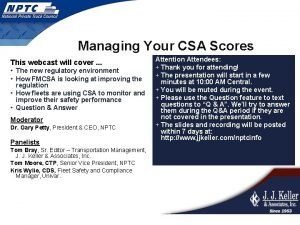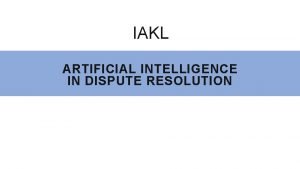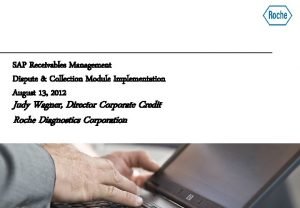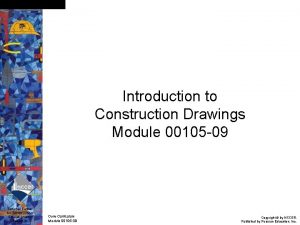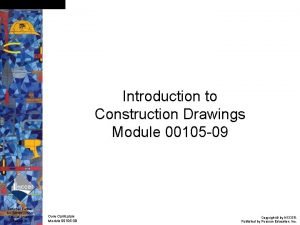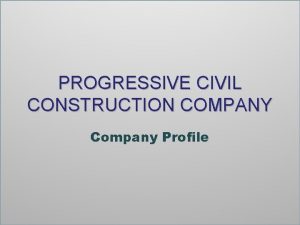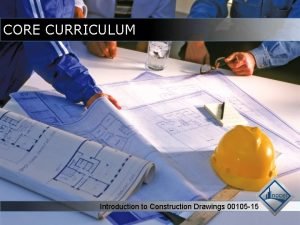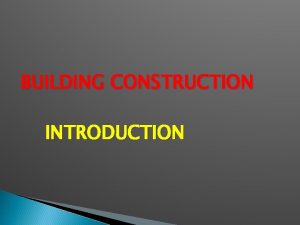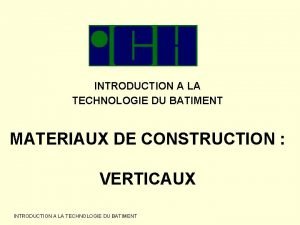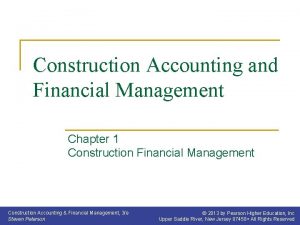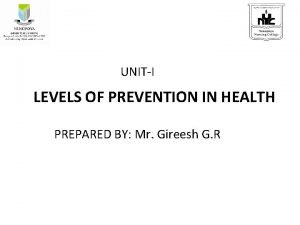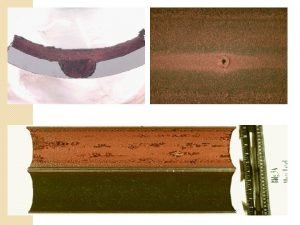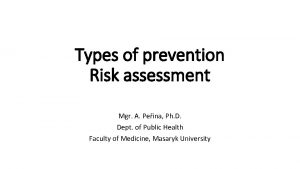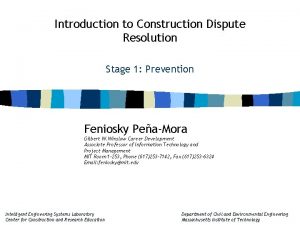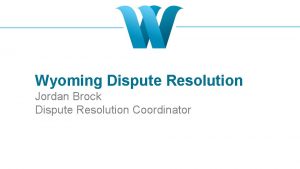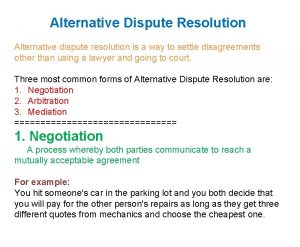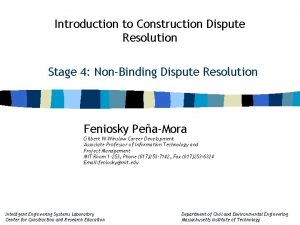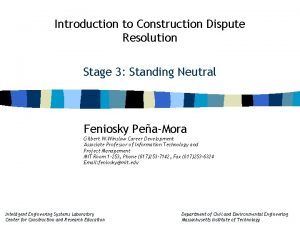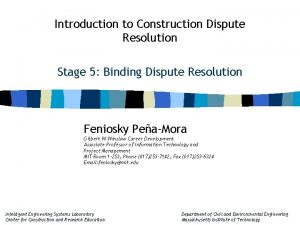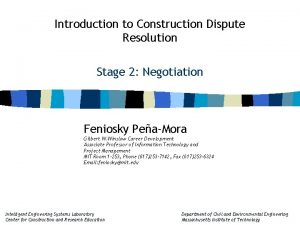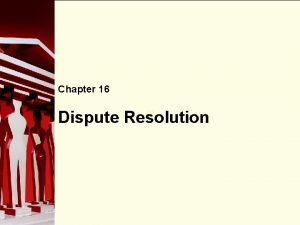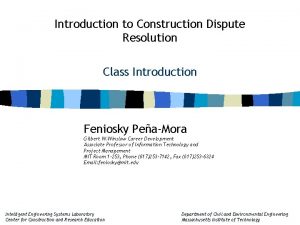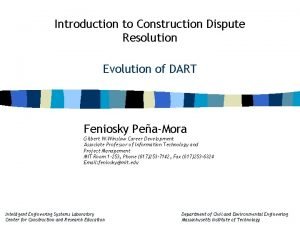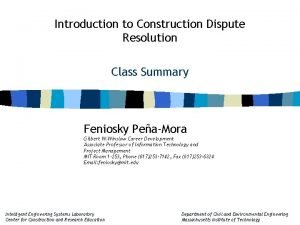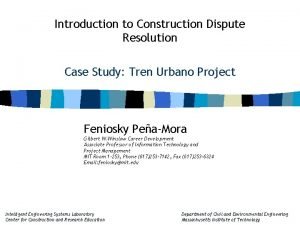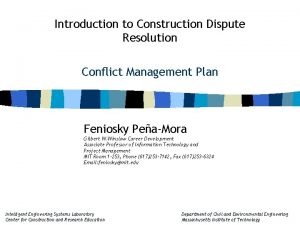Introduction to Construction Dispute Resolution Stage 1 Prevention













































- Slides: 45

Introduction to Construction Dispute Resolution Stage 1: Prevention Feniosky Peña-Mora Gilbert W. Winslow Career Development Associate Professor of Information Technology and Project Management MIT Room 1 -253, Phone (617)253 -7142, Fax (617)253 -6324 Email: feniosky@mit. edu Intelligent Engineering Systems Laboratory Center for Construction and Research Education Department of Civil and Environmental Engineering Massachusetts Institute of Technology

Definitions n WHAT • Prevention of Conflicts before They Happen • Different Techniques for Conflict Prevention: risk sharing, escrow bid documents, project award and delivery systems, incentive programs, constructability analysis, cost/schedule controls, and contract implementation. n WHO • Mainly the Owner with some involvement of the Contractor and the A/E n WHY • Preventing conflicts from becoming disputes , thus leading to high cost expenditures, delays and adversarial personal relationships n HOW • Review of the Sources of Conflicts in the Construction Industry • Application of Conflict Avoidance Techniques 2 Introduction to Construction Dispute Resolution Chapter 3: Prevention © Peña-Mora, et. al. 2002

Office Building Project n Joint Venture Between a Large Nationally Based Contractor and a Local Concrete Contractor for the Construction of an Office Structure n Guaranteed Maximum Price Contract of US$ 100 million With Design Complete at 80% n Imperative On-time Completion n Complications • The Design of the Upper Superstructure Occurring Simultaneously With the Garage Construction • The Steel Being Placed Simultaneously With the Interior Design Performed by a Second Architect 3 Introduction to Construction Dispute Resolution Chapter 3: Prevention © Peña-Mora, et. al. 2002

Case Study: Important Issues n Large, Fast Track and Multi-party Projects Are Conflict Prone Environments. n Preventing the Occurrence of Conflicts Is Essential in Such Projects. n In This Particular Case, Several Questions Should Be Raised: • GMP and Its Effect on Conflicts • Appropriateness of the Delivery System • Reduction of Misunderstandings Between Parties • Risk Allocation 4 Introduction to Construction Dispute Resolution Chapter 3: Prevention © Peña-Mora, et. al. 2002

Outline Ø n n n n 5 n Importance of Prevention Stage Equitable Risk Sharing • • • Economic Price Adjustment Geotechnical Baseline Report (GBR) Third Party Beneficiary Clause • • • Negotiated Compressed Process A+B Bidding PEp. C Delivery System “Bridging” the Design-Build Gap Frame Contract Delivery System in the Netherlands • • • Cost/Schedule Incentive Matrix Subjective Determination of Fee Superior Time Management Allowance • Constructability Analysis • • • Cost Statement Submittal Certified Payroll Submittal Negotiated Equipment and Labor Pricing Joint Project Scheduling Schedule Audits As-Built Schedule Submittal Forward-Price Change Orders Right of Refusal on Change-Order Cost Quotations Sub-Contractor Payment Requirements Escrow Bid Documents Project Award and Delivery Mechanism Incentive Programs Competent Engineering and Documentation Cost and Schedule Control Dispute Resolution Clauses Training and Development Introduction to Construction Dispute Resolution Chapter 3: Prevention © Peña-Mora, et. al. 2002

Importance of Prevention Stage n Initial Stage in the Dispute Resolution Ladder n Responsibility of the Owner n Dispute Avoidance Through: • Management of Design • Risk Sharing • Incentive Programs • Cost and Schedule Control • Peer Review • Value Engineering • Constructability Reviews n Minimal Costs Compared to Costs of Conflict Resolution Through Binding Procedures 6 Introduction to Construction Dispute Resolution Chapter 3: Prevention © Peña-Mora, et. al. 2002

Outline ü Ø n n n 7 n Importance of Prevention Stage Equitable Risk Sharing • • • Economic Price Adjustment Geotechnical Baseline Report (GBR) Third Party Beneficiary Clause • • • Negotiated Compressed Process A+B Bidding PEp. C Delivery System “Bridging” the Design-Build Gap Frame Contract Delivery System in the Netherlands • • • Cost/Schedule Incentive Matrix Subjective Determination of Fee Superior Time Management Allowance • Constructability Analysis • • • Cost Statement Submittal Certified Payroll Submittal Negotiated Equipment and Labor Pricing Joint Project Scheduling Schedule Audits As-Built Schedule Submittal Forward-Price Change Orders Right of Refusal on Change-Order Cost Quotations Sub-Contractor Payment Requirements Escrow Bid Documents Project Award and Delivery Mechanism Incentive Programs Competent Engineering and Documentation Cost and Schedule Control Dispute Resolution Clauses Training and Development Introduction to Construction Dispute Resolution Chapter 3: Prevention © Peña-Mora, et. al. 2002

Equitable Risk Sharing n Equitable Risk Allocation between Different Parties n Clear Definition of Basic Concessions, Project Agreements and DART System from the Start n Allocation of Uncertainty for the Benefit of all Parties and not Just for the Limitation of Individual Liabilities n Pros: • Reduction in Contingency Cost • More Effective Communication and Negotiation 8 Introduction to Construction Dispute Resolution Chapter 3: Prevention © Peña-Mora, et. al. 2002

Outline ü ü n n n 9 n Importance of Prevention Stage Equitable Risk Sharing Ø • • Economic Price Adjustment Geotechnical Baseline Report (GBR) Third Party Beneficiary Clause • • • Negotiated Compressed Process A+B Bidding PEp. C Delivery System “Bridging” the Design-Build Gap Frame Contract Delivery System in the Netherlands • • • Cost/Schedule Incentive Matrix Subjective Determination of Fee Superior Time Management Allowance • Constructability Analysis • • • Cost Statement Submittal Certified Payroll Submittal Negotiated Equipment and Labor Pricing Joint Project Scheduling Schedule Audits As-Built Schedule Submittal Forward-Price Change Orders Right of Refusal on Change-Order Cost Quotations Sub-Contractor Payment Requirements Escrow Bid Documents Project Award and Delivery Mechanism Incentive Programs Competent Engineering and Documentation Cost and Schedule Control Dispute Resolution Clauses Training and Development Introduction to Construction Dispute Resolution Chapter 3: Prevention © Peña-Mora, et. al. 2002

Economic Price Adjustment n Contract Clause Allowing Controlled Price Escalation during Project Life to Minimize Contractor’s Guesswork in Pricing n Importance of an Agreement on Risk Allocation and on Mechanisms Applied in Case of Price Escalation 10 Introduction to Construction Dispute Resolution Chapter 3: Prevention © Peña-Mora, et. al. 2002

How To 11 n Step 1: Clear Definition and Repartition of Building Costs n Step 2: Clear Definition of the ‘Established Price’ (Or Unit Price): Usage of Indices (e. g. Building Cost Index and Tender Price Index) n Step 3: Agreement on Ways To Account For Prices Escalation: Indices, Evolution of Inflation n Step 4 : Contractor’s Handling of Price Escalation Risks (Accept it, Shift it, Share it, Shrink it, Avoid it) n Step 5: Maximum Acceptable Level of Cost Increase-Safety Margin Introduction to Construction Dispute Resolution Chapter 3: Prevention © Peña-Mora, et. al. 2002

Example 1: Contract Price Adjustment Schedule n An Adjustment Factor Is Calculated For Each of the Bid Items : (1 -x) * [ a * Lt / L 0 + b * Pt/P 0+ c * Mt/M 0 + d * Ft/F 0 – 1] • X: the Portion of The Cost Ac Not Subject to Adjustment • a, b, c, and d represent the weighted value of labor, plant, materials and fuel respectively : E. g: Concrete Work n 12 Labor a Plant b Materials c Fuel d 0. 40 0. 10 0. 45 0. 05 Ac, the amount subject to adjustment is given by: Ac = T – S – D – E – G – Ap Introduction to Construction Dispute Resolution Chapter 3: Prevention © Peña-Mora, et. al. 2002

Example 2: Adjustment for Asphalt Cement in Paving Mixtures n Contract Unit Price Taken Equal to the “Basic Bituminous Material Index” n Price Adjustments Function of Deviation of the “Basic Bituminous Material Index” from the “Monthly Bituminous Material Index” n Adjustments in Contract Price Allowed Only for Deviations Changing at 5% Increments 13 Introduction to Construction Dispute Resolution Chapter 3: Prevention © Peña-Mora, et. al. 2002

Calculation Sample n Basic Bituminous Material Index = $ 121. 00 14 Introduction to Construction Dispute Resolution Chapter 3: Prevention © Peña-Mora, et. al. 2002

Outline ü ü n n n 15 n Importance of Prevention Stage Equitable Risk Sharing ü Ø • Economic Price Adjustment Geotechnical Baseline Report (GBR) Third Party Beneficiary Clause • • • Negotiated Compressed Process A+B Bidding PEp. C Delivery System “Bridging” the Design-Build Gap Frame Contract Delivery System in the Netherlands • • • Cost/Schedule Incentive Matrix Subjective Determination of Fee Superior Time Management Allowance • Constructability Analysis • • • Cost Statement Submittal Certified Payroll Submittal Negotiated Equipment and Labor Pricing Joint Project Scheduling Schedule Audits As-Built Schedule Submittal Forward-Price Change Orders Right of Refusal on Change-Order Cost Quotations Sub-Contractor Payment Requirements Escrow Bid Documents Project Award and Delivery Mechanism Incentive Programs Competent Engineering and Documentation Cost and Schedule Control Dispute Resolution Clauses Training and Development Introduction to Construction Dispute Resolution Chapter 3: Prevention © Peña-Mora, et. al. 2002

Geotechnical Baseline Report n Sub-surface Soil Conditions, a Primary Source of Conflicts and Delays n Geotechnical Baseline Report • Owner’s Responsibility • Interpretation of Soils Borings and Test Results, and Possible Subsurface Conditions n Results: More Competitive bids, Improved Assessment of Costs, Schedules and Uncertainties 16 Introduction to Construction Dispute Resolution Chapter 3: Prevention © Peña-Mora, et. al. 2002

Geotechnical Baseline Report: How-To n Roles and Responsibilities of Participants after the provision of a GBR • Owner • Design Engineer • Geotechnical Engineer • Contractor • Construction Manager 17 • Dispute Adjudicator Introduction to Construction Dispute Resolution Chapter 3: Prevention © Peña-Mora, et. al. 2002

Toronto Transit Commission Case n Risk Sharing Techniques • Tunnel Boring Machines (TBM) Provided by TTC, the Owner • Maintenance, Operation and Head Dressings Supply of the TBM as the Contractor’s Responsibility • Regular Service and Supervision by the TBM Supplier • Purchase of Precast Concrete Liners by TTC • Geotechnical Baseline Report Available to All Parties • Monitoring, Construction Insurance and Quality Control Assumed by TTC • Real-time Data Available to All Parties 18 n On-site Partnering with Scheduled Off-site Retreats n Dispute Review Board Introduction to Construction Dispute Resolution Chapter 3: Prevention © Peña-Mora, et. al. 2002

Outline ü ü n n n 19 n Importance of Prevention Stage Equitable Risk Sharing ü ü Ø Economic Price Adjustment Geotechnical Baseline Report (GBR) Third Party Beneficiary Clause • • • Negotiated Compressed Process A+B Bidding PEp. C Delivery System “Bridging” the Design-Build Gap Frame Contract Delivery System in the Netherlands • • • Cost/Schedule Incentive Matrix Subjective Determination of Fee Superior Time Management Allowance • Constructability Analysis • • • Cost Statement Submittal Certified Payroll Submittal Negotiated Equipment and Labor Pricing Joint Project Scheduling Schedule Audits As-Built Schedule Submittal Forward-Price Change Orders Right of Refusal on Change-Order Cost Quotations Sub-Contractor Payment Requirements Escrow Bid Documents Project Award and Delivery Mechanism Incentive Programs Competent Engineering and Documentation Cost and Schedule Control Dispute Resolution Clauses Training and Development Introduction to Construction Dispute Resolution Chapter 3: Prevention © Peña-Mora, et. al. 2002

Third Party Beneficiary Clause n Problems Arise When One Contractor’s Work Has Repercussion on Others’ Works, Triggering Claims Against the Owner, the Only Entity With Whom All Contractors Have Binding Contracts. n Each Company (Contractors and Sub-contractors) Is Considered the “Intended Third-party Beneficiary” of All Other Contracts If a “Third-party Beneficiary”clause Is Provided in Each Contract. n Advantages: • Owner Sharing the Risks of Delays Among All Contractors and Subcontractors • Owner Avoiding Claims Not Caused by Them and Contractors Seeking Relief for Delays Caused by Other Parties Directly • Less Strained Relationships 20 Introduction to Construction Dispute Resolution Chapter 3: Prevention © Peña-Mora, et. al. 2002

Third Party Beneficiary Clause: How-To n “The Contract represents the entire and integrated agreement between the parties hereto and supersedes prior negotiations representations or agreements, either written or oral. The Contract may be amended or modified only by a Modification. The Contract Documents shall not be construed to create a contractual relationship of any kind i. between the Architect and Contractor ii. between the Owner and a Subcontractor or Subcontractor iii. between any personalities other than the Owner and Contractor. The Architect shall, however, be entitled to performance and enforcement of obligations under the Contract intended to facilitate performance of the Architect’s duties. ” (AIA) 21 Introduction to Construction Dispute Resolution Chapter 3: Prevention © Peña-Mora, et. al. 2002

Outline ü ü Ø n n n 22 n Importance of Prevention Stage Equitable Risk Sharing ü ü ü Economic Price Adjustment Geotechnical Baseline Report (GBR) Third Party Beneficiary Clause • • • Negotiated Compressed Process A+B Bidding PEp. C Delivery System “Bridging” the Design-Build Gap Frame Contract Delivery System in the Netherlands • • • Cost/Schedule Incentive Matrix Subjective Determination of Fee Superior Time Management Allowance • Constructability Analysis • • • Cost Statement Submittal Certified Payroll Submittal Negotiated Equipment and Labor Pricing Joint Project Scheduling Schedule Audits As-Built Schedule Submittal Forward-Price Change Orders Right of Refusal on Change-Order Cost Quotations Sub-Contractor Payment Requirements Escrow Bid Documents Project Award and Delivery Mechanism Incentive Programs Competent Engineering and Documentation Cost and Schedule Control Dispute Resolution Clauses Training and Development Introduction to Construction Dispute Resolution Chapter 3: Prevention © Peña-Mora, et. al. 2002

Escrow Bid Documents n Documents Used by Contractor in Bid Preparation: Information Regarding Pricing, Production Rates, Equipment Selection, Contract, Changes to Contract, Supplementary Conditions n Documents Excluding Confidential Information Such as Mark-ups and Fees n Documents Given to a Third Party Neutral n Advantages: • Basis for the Review of any Claim Regarding Original Information (Bidding Information, Productivity factors, interpretation of details, Quantity Take-off…) 23 • Deterrence of Unfounded Claims from the Contractor Introduction to Construction Dispute Resolution Chapter 3: Prevention © Peña-Mora, et. al. 2002

Escrow Bid Documents: How-To n Security Measures to Avoid any Mishap: • Bid Documents Are the Contractor’s Property and Cannot Be Accessed Under the Freedom of Information Act in Public Projects • The Neutral Third Party Will Be Present In Case If The Seal Is To Be Broken. • The Documents Must Be Returned To The Contractor At The Completion Of The Project. 24 Introduction to Construction Dispute Resolution Chapter 3: Prevention © Peña-Mora, et. al. 2002

Outline ü ü n n 25 n Importance of Prevention Stage Equitable Risk Sharing ü ü ü Economic Price Adjustment Geotechnical Baseline Report (GBR) Third Party Beneficiary Clause Ø • • Negotiated Compressed Process A+B Bidding PEp. C Delivery System “Bridging” the Design-Build Gap Frame Contract Delivery System in the Netherlands • • • Cost/Schedule Incentive Matrix Subjective Determination of Fee Superior Time Management Allowance • Constructability Analysis • • • Cost Statement Submittal Certified Payroll Submittal Negotiated Equipment and Labor Pricing Joint Project Scheduling Schedule Audits As-Built Schedule Submittal Forward-Price Change Orders Right of Refusal on Change-Order Cost Quotations Sub-Contractor Payment Requirements Escrow Bid Documents Project Award and Delivery Mechanism Incentive Programs Competent Engineering and Documentation Cost and Schedule Control Dispute Resolution Clauses Training and Development Introduction to Construction Dispute Resolution Chapter 3: Prevention © Peña-Mora, et. al. 2002

Negotiated Compressed Process n New Bidding-selection Process Developed for Earthwork and Tunneling Jobs to Reduce the Number of Interpretations Given to Contract Documents n Contract Award Steps: • Step 1: Qualification • Step 2: Meeting Between Contractors, Owner and Designers (Equipment, Pricing Criteria. . ) To Decide on the Best Type of Equipment and Other Critical Parameters • Step 3: Bidding and Contract Award to Lowest Bidding n Early Elimination of Certain Project Uncertainties Associated With Equipment, Productivity and Schedule Sequence 26 Introduction to Construction Dispute Resolution Chapter 3: Prevention © Peña-Mora, et. al. 2002

Negotiated Compressed Process: How-To and Example Alternative s TCBP DBP Advantages Duration Disadvantages (mo nth s) 45 33 Long duration Lost market opportunities Exactly follows standard contracting procedures Lowest risk Early start Start before all approvals obtained CN North Ameruca loses some control of project management and quality control Difficult to select a team. ABP 33 Early start NCP 27 33 Early start Follows approval procedure for construction start Introduction to Construction Dispute Resolution Difficult negotiations Contract awarded on conceptual engineering Start before all approvals obtained Requires pre-ordering machine and liner before all approvals obtained Unanimity for selection of TBM Chapter 3: Prevention may be difficult © Peña-Mora, et. al. 2002

Negotiation Steps for St. Clair Tunnel n Step 1: Pre-qualification Process n Step 2: Joint Decisions of the Technical Committee n Step 3: Awarding the Contract to the Lowest Bidder 28 Introduction to Construction Dispute Resolution Chapter 3: Prevention © Peña-Mora, et. al. 2002

Outline ü ü n n 29 n Importance of Prevention Stage Equitable Risk Sharing ü ü ü Economic Price Adjustment Geotechnical Baseline Report (GBR) Third Party Beneficiary Clause ü Ø • • • Negotiated Compressed Process A+B Bidding PEp. C Delivery System “Bridging” the Design-Build Gap Frame Contract Delivery System in the Netherlands • • • Cost/Schedule Incentive Matrix Subjective Determination of Fee Superior Time Management Allowance • Constructability Analysis • • • Cost Statement Submittal Certified Payroll Submittal Negotiated Equipment and Labor Pricing Joint Project Scheduling Schedule Audits As-Built Schedule Submittal Forward-Price Change Orders Right of Refusal on Change-Order Cost Quotations Sub-Contractor Payment Requirements Escrow Bid Documents Project Award and Delivery Mechanism Incentive Programs Competent Engineering and Documentation Cost and Schedule Control Dispute Resolution Clauses Training and Development Introduction to Construction Dispute Resolution Chapter 3: Prevention © Peña-Mora, et. al. 2002

A+B Bidding n Mainly for Public Owners in the US n Total Bid Price = (A-term) + (B-term) • A-term = Total Project Cost • B-term = Cost Per Day x Time of Performance • Award Based on the Lowest Total Project Cost n Advantages: • Shortest Feasible Construction Schedule to Keep B-term Low • Project Accomplished within the Time Limit to Gain the Bonus (B-term) 30 Introduction to Construction Dispute Resolution Chapter 3: Prevention © Peña-Mora, et. al. 2002

Assessing the Cost Per Day n Cost per Day: A* t*w*f*d • A=Average Cost Borne by the Owner Per Year • t=Additional Time Required By Users to Continue Their Activities In spite of the Construction Works • w=Average Wage of Facility User • f=Factor Taking Into Account Impacts to Local Businesses and Safety • d=The Duration of a Specific Control of the Facility Divided by the Estimated Duration of the Project 31 Introduction to Construction Dispute Resolution Chapter 3: Prevention © Peña-Mora, et. al. 2002

Example: ADOT n Highway Rehabilitation or Construction Projects: Arizona Department of Transportation 32 Introduction to Construction Dispute Resolution Chapter 3: Prevention © Peña-Mora, et. al. 2002

Outline ü ü n n 33 n Importance of Prevention Stage Equitable Risk Sharing ü ü ü Economic Price Adjustment Geotechnical Baseline Report (GBR) Third Party Beneficiary Clause ü ü Ø • • Negotiated Compressed Process A+B Bidding PEp. C Delivery System “Bridging” the Design-Build Gap Frame Contract Delivery System in the Netherlands • • • Cost/Schedule Incentive Matrix Subjective Determination of Fee Superior Time Management Allowance • Constructability Analysis • • • Cost Statement Submittal Certified Payroll Submittal Negotiated Equipment and Labor Pricing Joint Project Scheduling Schedule Audits As-Built Schedule Submittal Forward-Price Change Orders Right of Refusal on Change-Order Cost Quotations Sub-Contractor Payment Requirements Escrow Bid Documents Project Award and Delivery Mechanism Incentive Programs Competent Engineering and Documentation Cost and Schedule Control Dispute Resolution Clauses Training and Development Introduction to Construction Dispute Resolution Chapter 3: Prevention © Peña-Mora, et. al. 2002

PEp. C Delivery System n Procurement, Engineering, procurement and Construction n Negotiation and Procurement of Critical Pieces of Equipment and Materials before the Actual Engineering Process n Benefits • Improved Quality of the Detail Design • Improved System and Facility Performance • More Equitable Allocation of Risk • Improved Utilization of Supplier Core Competencies • Reduction or Elimination of Redundant Work 34 • Non-core Competencies more Effectively Maintained and Delivered by Suppliers Introduction to Construction Dispute Resolution Chapter 3: Prevention © Peña-Mora, et. al. 2002

PEp. C : How-To EPC Business Plan - Define Objectives - Define Facility Objectives - Define Startup Requirements Project Technical Plan - Conduct Technical Surveys and Process Analysis PEp. C Familiarization and Awareness PEp. C Strategy Development Facility Scope Plan - Plan Process and Facility - Develop Site Plan - Detail Work Breakdown Project Execution Plan - Develop Preliminary Design Criteria - Complete Preliminary Estimate - Establish Master Project Schedule Contract Strategy - Develop Bid Package Scope - Review and Select Contractors 35 - Identify Strategic Procurement Items - Identify Members of Project Team PEp. C Execution Plan - Obtain Agreement and Commitment - Establish Cost and Time Baselines - Define Criteria for Supplier Selection PEp. C Supplier Selection - Obtain Proposals - Review Proposals - Refine and Finalize Strategies PEp. C Commitment - Obtain Funding Approval - Make Commitments to Suppliers Project Team Integration Develop plan for integrating supplier design capability into project. Implement plan during appropriate time in project cycle. Introduction to Construction Dispute Resolution Chapter 3: Prevention © Peña-Mora, et. al. 2002

Example : Georgia Pacific and Brown & Root n Example of an “Improved” EPC Process n Changes to the Original EPC Process: • Participation of Brown & Root in the Preliminary Feasibility of the Project • Selection of Valmet, the Paper Machine Supplier During the Team Selection Phase • Selection of Four Other Strategic Suppliers During the Preliminary Design, Estimating and Scope Definition Phase • Other Changes Outside the Scope of Our Analysis n Results • Reduction of Project Duration By 5. 5% 36 Introduction to Construction Dispute Resolution Chapter 3: Prevention © Peña-Mora, et. al. 2002

Outline ü ü n n 37 n Importance of Prevention Stage Equitable Risk Sharing ü ü ü Economic Price Adjustment Geotechnical Baseline Report (GBR) Third Party Beneficiary Clause ü ü ü Ø • Negotiated Compressed Process A+B Bidding PEp. C Delivery System “Bridging” the Design-Build Gap Frame Contract Delivery System in the Netherlands • • • Cost/Schedule Incentive Matrix Subjective Determination of Fee Superior Time Management Allowance • Constructability Analysis • • • Cost Statement Submittal Certified Payroll Submittal Negotiated Equipment and Labor Pricing Joint Project Scheduling Schedule Audits As-Built Schedule Submittal Forward-Price Change Orders Right of Refusal on Change-Order Cost Quotations Sub-Contractor Payment Requirements Escrow Bid Documents Project Award and Delivery Mechanism Incentive Programs Competent Engineering and Documentation Cost and Schedule Control Dispute Resolution Clauses Training and Development Introduction to Construction Dispute Resolution Chapter 3: Prevention © Peña-Mora, et. al. 2002

“Bridging” the Design-Build Gap n Problems Associated with Design-Build Projects • Gap Between the Owner and the Design Process • Selection of Design Firm on Price Basis Rather Than Qualification Basis • Less Competition in the Selection and Award Phases • Final Product Failing to Meet Original Project Criteria n Bridging the Gap • Stage 1 : Conceptual Design by Design Consultant • Stage 2 : Design and Drawings by Design-build Team 38 • Stage 3 : Construction by Contractor and Inspection by Bridging Consultant Introduction to Construction Dispute Resolution Chapter 3: Prevention © Peña-Mora, et. al. 2002

The Pittsburgh Pirates Case n Project: Development of the High-Performance Field of PNC Park, Owned by Pittsburgh Pirates n Process Implementation • Phase 1 : Preliminary Design • Phase 2 : Design-Build or “Prose Process” • Phase 3: The Construction • Supervision of the Work by the Bridging Consultant • DCM With the Obligation to Terminate On Time and Within Budget 39 Introduction to Construction Dispute Resolution Chapter 3: Prevention © Peña-Mora, et. al. 2002

Phase 1: Preliminary Design n Hiring HOK Architects Inc. As Bridging Consultant to Develop Conceptual Design; n Selection of a Design and Construction Manager (DCM) After Qualification and Competitive Pricing Bid; n Determination of Basis and Limit of GMP By DCM 40 Introduction to Construction Dispute Resolution Chapter 3: Prevention © Peña-Mora, et. al. 2002

Phase 2: Design-Build 41 n Agreement Between the Pirates, the Bridging Consultant and DCM on the Structure and Content of of the Design Development Document Set (DD Set) n Bridging Consultant Delivering to DCM 90% Complete DD Set to DCM n Complete DD set Delivery (3 Weeks Later) and “Prose Statement” (Definition of Scope Taking into Account Incomplete Design elements) n Proposal of DCM for the GMP (Within 2 Weeks) n Facilitated Session : Resolving Discrepancies and Disagreements About the DD Set, the Draft Prose Statement, the Proposed GMP and GMP Qualifications and Assumptions n DCM Proposal of Final GMP n Agreement on Final GMP, Final Prose Statement, Qualifications and Assumptions Integrated into an Amendment to DCM Agreement (Possibility of Contract Termination If Agreement Is Not Reached) Introduction to Construction Dispute Resolution Chapter 3: Prevention © Peña-Mora, et. al. 2002

Phase 3 : The Construction n Supervision of the Work by the Bridging Consultant n DCM With the Obligation to Terminate On Time and Within Budget 42 Introduction to Construction Dispute Resolution Chapter 3: Prevention © Peña-Mora, et. al. 2002

Outline ü ü n n 43 n Importance of Prevention Stage Equitable Risk Sharing ü ü ü Economic Price Adjustment Geotechnical Baseline Report (GBR) Third Party Beneficiary Clause ü ü Ø Negotiated Compressed Process A+B Bidding PEp. C Delivery System “Bridging” the Design-Build Gap Frame Contract Delivery System in the Netherlands • • • Cost/Schedule Incentive Matrix Subjective Determination of Fee Superior Time Management Allowance • Constructability Analysis • • • Cost Statement Submittal Certified Payroll Submittal Negotiated Equipment and Labor Pricing Joint Project Scheduling Schedule Audits As-Built Schedule Submittal Forward-Price Change Orders Right of Refusal on Change-Order Cost Quotations Sub-Contractor Payment Requirements Escrow Bid Documents Project Award and Delivery Mechanism Incentive Programs Competent Engineering and Documentation Cost and Schedule Control Dispute Resolution Clauses Training and Development Introduction to Construction Dispute Resolution Chapter 3: Prevention © Peña-Mora, et. al. 2002

Frame Contract Delivery System in the Netherlands 44 n Suitable For Complex Projects Where Rapid Adaptation of the Design and Execution Plans Is Needed During Construction n Agreement on Negotiation Modes, Rules for Quality Control, Timing and Pricing n Studies and Construction Plans in Constant Modification to Optimize Efficiency and Insure Completion on Schedule n Handling Construction as a Dynamic Process Within Well-defined Relational Contracts Introduction to Construction Dispute Resolution Chapter 3: Prevention © Peña-Mora, et. al. 2002

Outline ü ü Ø n n n 45 n Importance of Prevention Stage Equitable Risk Sharing ü ü ü Economic Price Adjustment Geotechnical Baseline Report (GBR) Third Party Beneficiary Clause ü ü ü Negotiated Compressed Process A+B Bidding PEp. C Delivery System “Bridging” the Design-Build Gap Frame Contract Delivery System in the Netherlands • • • Cost/Schedule Incentive Matrix Subjective Determination of Fee Superior Time Management Allowance • Constructability Analysis • • • Cost Statement Submittal Certified Payroll Submittal Negotiated Equipment and Labor Pricing Joint Project Scheduling Schedule Audits As-Built Schedule Submittal Forward-Price Change Orders Right of Refusal on Change-Order Cost Quotations Sub-Contractor Payment Requirements Escrow Bid Documents Project Award and Delivery Mechanism Incentive Programs Competent Engineering and Documentation Cost and Schedule Control Dispute Resolution Clauses Training and Development Introduction to Construction Dispute Resolution Chapter 3: Prevention © Peña-Mora, et. al. 2002
 Msc in construction law
Msc in construction law Primary prevention secondary prevention tertiary prevention
Primary prevention secondary prevention tertiary prevention Policy on harassment prevention and resolution
Policy on harassment prevention and resolution High resolution low resolution
High resolution low resolution Construction site theft prevention
Construction site theft prevention What is labour law in india
What is labour law in india Krishna godavari dispute
Krishna godavari dispute Objectives of industrial dispute act 1947
Objectives of industrial dispute act 1947 Wto dispute settlement mechanism
Wto dispute settlement mechanism Dispute settlement mechanism meaning
Dispute settlement mechanism meaning Rights dispute
Rights dispute Objectives of industrial dispute act 1947
Objectives of industrial dispute act 1947 Maine vs canada war
Maine vs canada war Unit 1 dispute solving in civil law
Unit 1 dispute solving in civil law Example of relic boundary
Example of relic boundary Uces dispute letters
Uces dispute letters Delimited boundary ap human geography
Delimited boundary ap human geography How to dispute csa points
How to dispute csa points Dispute management ai
Dispute management ai Delay and dispute mitigation
Delay and dispute mitigation Receivables management sap
Receivables management sap Dispute management in order to cash
Dispute management in order to cash Rapport de stage fabrication mécanique
Rapport de stage fabrication mécanique Basics of drama
Basics of drama Stage one denial stage two
Stage one denial stage two Staging position
Staging position Proscenium stage template
Proscenium stage template Two-stage tendering disadvantages
Two-stage tendering disadvantages What is drama
What is drama Stage left and right
Stage left and right Module 00105 introduction to construction drawings
Module 00105 introduction to construction drawings 00105 introduction to construction drawings
00105 introduction to construction drawings Construction company introduction
Construction company introduction Construction math curriculum
Construction math curriculum Module 00105-15 introduction to construction drawings
Module 00105-15 introduction to construction drawings Introduction to building construction
Introduction to building construction Introduction sur les matériaux de construction
Introduction sur les matériaux de construction Compiler vs interpreter advantages and disadvantages
Compiler vs interpreter advantages and disadvantages Construction accounting and financial management
Construction accounting and financial management Peak stage fashion cycle
Peak stage fashion cycle Rapport structure
Rapport structure Primordial prevention
Primordial prevention Primordial prevention
Primordial prevention Stress corrosion
Stress corrosion Type of prevention
Type of prevention Corrosion prevention casing filler
Corrosion prevention casing filler








